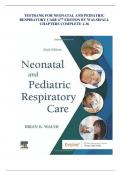Exam (elaborations)
TESTBANK FOR NEONATAL AND PEDIATRIC RESPIRATORY CARE 6TH EDITION BY WALSH/ALL CHAPTERS COMPLETE 1-36
- Course
- Institution
- Book
TESTBANK FOR NEONATAL AND PEDIATRIC RESPIRATORY CARE 6TH EDITION BY WALSH/ALL CHAPTERS COMPLETE 1-36
[Show more]



